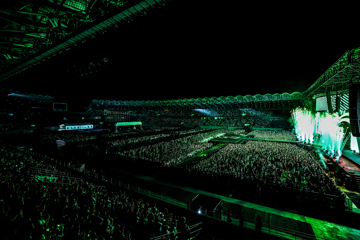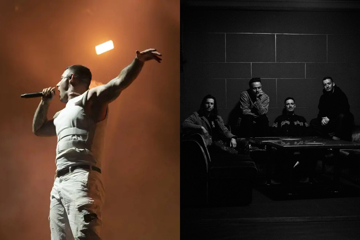'It Comes At Night' Takes Post-apocalyptic Films To The Next Level
"Given such scant information, our brains run wild with possibility."
IT COMES AT NIGHT

Like his great debut film, 2015’s Krisha, Trey Edward Shults’ second picture, It Comes At Night, is set in a solitary house, and tracks the shifting dynamic — the ebb-and-flow of group communication, the complex emotional currents, the psychological warfare — of an extended family holed up within. Only, this time, it’s a remote woodland house in some post-apocalyptic future, in which a pandemic has swept through cities, plunging the world into the kind of survivalist state — with men and women returning to traditional social/domestic roles — that tin-can hoarders have long envisioned. Guns, batteries, and clean water have cultural capital. Your family, property, and possessions are to be protected at all costs. And no one is to be trusted. Least of all the characters of this story.
Shults, again, shows an astonishing sense of control, command of pace, and mastery of mood; creating a claustrophobic air that smothers audiences. We’re thrown into this post-social-collapse world, but rarely thrown a bone; told the fate of the outside world, never shown it. “Do you have any idea what’s going on out there?” Joel Edgerton asks, early in the film, and the answer is a hard no. The not-knowing is a key to It Comes At Night, whose most profound feeling is one of isolation, for both character and audience. Given such scant information, our brains run wild with possibility; whilst the lack of an outside world, as reference, increases the sense of paranoia, both in the film’s world and in the theatre.
Don't miss a beat with our FREE daily newsletter
A house in the woods, in an era with no power or social order, is its own contained world, from which there is no escape; its darkness and distance lending the family-home, here, the spookiness of an old shack in a slasher film. Krisha was notable for how it turned a family dinner into its own kind of horror-movie, and It Comes At Night moves further towards true horror, even though those expecting genre convention will leave disappointed.
We meet our central family — Edgerton, Carmen Ejogo, and son Kelvin Harrison Jr. — at what’s, usually, the emotional downpoint delivered deep into a zombie/contagion movie: having to kill an infected love-one. Grandpa David Pendleton is bundled up into a wheelbarrow, taken out into the forest, shot in the head, tossed into a shallow grave, and set ablaze. Life, in this gloomy, non-electrified future is hard; with Hieronymous Bosch’s Garden Of Earthly Delights looming on the wall, mirroring this hellish time.
A light shines when another family — couple Christopher Abbott and Riley Keough, their young kid Griffin Robert Faulkner — arrive. The two merge tribes, pool collective resources, and double the size of their micro-society. At first, it’s a joyous union, but, even amidst the group bonding, mistrust and suspicion linger, slowly turning the relations toxic. Edgerton lectures Harrison that, in times like these, family is the only thing you can trust; blood running thicker than water, especially when it’s spilt.
Harrison is, for much of It Comes At Night, the audience’s ‘in’. A spooked, nervy teenager, he’s a silent watcher, an eavesdropper; posed by the script, with due misdirection, as pure observer. In truth, he’s haunted by nightmares, and sometimes has trouble distinguishing them from reality. Like everyone living cooped up in this enclave, he, too, is growing increasingly paranoid. When there’s a possibility that the deadly germs have entered the house, soon, everyone turns on each other, guns pointed this way and that. Its grim, ironic final shot underlines the film’s central question: what’s more dangerous, a pandemic or the paranoia it feeds?
THE BEGUILED

The Beguiled, too, is set in a solitary house in the middle of the woods, an island of humanity adrift amidst calamity. It’s deep into the US Civil War, and in the Virginian countryside, a plantation house has become an isolated bastion of high-society: a finishing school for girls in which Nicole Kidman and Kirsten Dunst preside over lessons in needlework, French conjugation, and cursive. With cannonfire from nearby battlefields ringing out over the hills, there’s due dissonance; Coppola, again, exploring her favourite themes of female identity and lives of privilege. With its wrought-iron gate and imposing greek columns, her house is a fortress, an enclave of femininity, its constituents blonde, well-mannered, and clad forever in white.
This micro-society is interrupted with the arrival of man. Colin Farrell, a Yankee soldier, is found gravely wounded in the woods, and brought back home to recuperate. At first, he’s taken as prisoner, but a mutual pact is undertaken when the home chooses not to report him to authorities, and send him out towards certain death. Farrell is a raffish interloper, a charismatic rogue peddling apologetic flattery and eyelid-fluttering flirtations, throwing the women of the house into a whirl.
In both Thomas P. Cullinan’s original 1966 novel and Don Siegel’s 1971 Clint Eastwood-starring to-screen adaptation, this captured soldier is an exemplar of male power and sexual potency; a fox thrown into a henhouse. But, here, director Sofia Coppola tells the story from a female perspective: Farrell’s soldier essentially a blank canvas on which the seven women of the house can project their own desires, be they philosophical or sexual. Coppola’s greatest change, as screenwriter, is to change the tone: from pulpy and macho to wry and knowing. Whilst the trailer (see below) is cut as if psychological-thriller, this Beguiled is a comedy-of-manners, in which symbolic castration is played not for horror, but laughs.
This makes for a movie that could be read as slight: a mild, amusing delight that barely stretches past 90 minutes. But, there’s a reason why Coppola won Best Diector at Cannes for her work, here. Shooting on celluloid, with able help from DOP Philippe Le Sourd (last seen earning an Oscar nom for his work on Wong Kar-wai’s The Grandmaster), Coppola makes a film in which every frame feels like a painting. The photography is largely low-light, with sun and candlelight leant on. The focus is shallow, the images ghostly: diaphanous Spanish moss dangling its threads into frame, rolling fogs blanketing the film in a spectral mist. It’s a gorgeous film to watch, and experience; an act of sweet, sly cinematic sedition, in which an old story is retold —and rephotographed— from a different perspective.
CHASING CORAL

It’s an environmental holocaust, happening on our doorstop: in 2016, 29% of the coral on the Great Barrief Reef bleached, leaving behind an eerie graveyard of coral skeletons and necrotic tissue. It’s the most tangible, tragic result of the effects of climate change: rising sea temperatures delivering a deadly dose of fever to one of the planet’s most amazing organisms, the centre of an underwater ecosystem. Coral is a bellwether of oceanic health, and, in turn, greater planetary health. And up to a billion people owe their livelihoods —from food to tourist economies— to the world’s reefs, meaning their preservation doesn’t stand at odds with capitalism.
Chasing Coral marks Jeff Orlowski’s sister picture to 2012’s Chasing Ice, a film that catalogued the world’s melting glaciers, themselves a symbol of a changing, degrading environment. Again, Orlowski sets this monolithic tragedy against the human spirit, juxtaposing the cataclysmic changes with our sense of wide-eyed wonder and capacity for ingenuity. There’s the giddy excitement of coral nerds talking about organisms, spectacular footage of the “alien world” existing under our oceans, and a central narrative where various scientists and engineers band together to photograph —by hand and by time-lapse remote— the bleaching events as they happen.
It’s an oceanic adventure that, ultimately, plays as a slow, sinking descent into despair; an eco-horror movie in which viewers witness death on a mass scale. Chasing Coral ends, as documentaries of this the-world-is-fucked ilk always do, with some notes of optimism and a website to visit, but there’s little hope to be taken from a hopeless situation. Like the photographers within, capturing a record of environmental decay, the film already feels like a postcard from a time bound for the history books: back when the great coral reefs still existed.
CHICKEN PEOPLE

The comparison follows Chicken People everywhere it goes: it’s like Best In Show, but not a mockumentary. Nicole Lucas Haimes’ film is a for-real collection of bird breeders, Middle-American oddballs who raise scores of chooks to compete in regional competitions. They’re proud Chicken People, a brood of nerds from whom Haimes selects three ‘stars’. There’s Brian, a showtune-crooner; another Brian, a nerdy engineer in specs; and Shari, mother to many children and countless animals.
It’s a film about these folksy folk: quirky obsessives whose love of chickens is an insight into who they are, and where they’re coming from. Unlike Mark Lewis’s The Natural History Of The Chicken, there’s little exploration of what chickens mean, culturally; how this bird born under a bad sign is slaughtered, annually, in untold billions, sentient beings living and dying under the dominion of industrialised man. We hear various talking-heads speaking of their love of birds —how they groom them, communicate with them, let them in the house— but don’t get much of a sense of chickens themselves.
What we get is what we usually do in these ‘micro-subculture’ documentaries: a looming competition, frantic preparation, show-day nerves, dashed dreams, a final judgment. There’s winners and losers; smiles and tears and hugs. It’s non-threatening cinema, but plenty charming.







